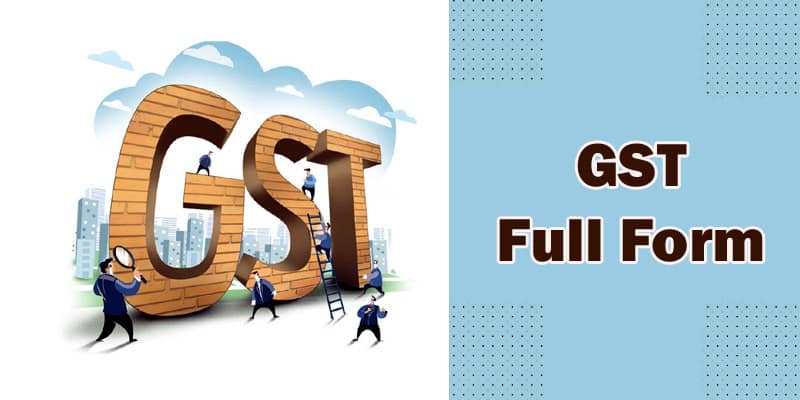GST stands for Goods and Services Tax, and it is levied by the Central or State Government on the supply of goods or services at each stage of the supply chain, from manufacture or import to the final retail level. This article discusses the GST Full Form and its history, features, types, and benefits, among other things.
History
In the year 2000, the then Prime Minister, Atal Bihari Vajpayee, introduced GST and set up a committee headed by the Finance Minister of West Bengal, Asim Dasgupta, to design a GST model for the country. In 2002, a task force was formed under Vijay Kelkar to recommend tax reforms. In 2005, the Kelkar committee recommended rolling out GST to replace the existing tax regime, which includes all indirect taxes in all value chain stages except customs duty.
The movement towards GST was announced in the budget speech of 2006 by the then finance minister, P. Chidambaran. It was proposed to implement it by the year 2010. Eventually, the Constitution (122nd Amendment) Bill was introduced in the 16th Lok Sabha in 2014 to address all issues related to the GST. Finally, the GST was launched at midnight on July 1st, 2017 by the President of India and the Government of India.
Objective
The primary goal of implementing GST was to reduce the cascading effect, or double taxation, of indirect taxes. GST is being proposed as a dual levy, with the Central Government levying and collecting Central GST (CGST) and the States levying and collecting State GST (SGST) on intra-state supplies of goods or services. On inter-state supplies of goods or services, the Centre will also levy and collect Integrated GST (IGST). As a result, GST acts as a unifier, integrating various taxes imposed by the Centre and the States, resulting in a single national market, a common tax base, and common tax laws.
Salient features of GST
- GST applies to the supply of goods or services against the earlier concept of the manufacture of goods or sale of goods or provision of services.
- Imports of goods or services are treated as inter-state supplies and subject to IGST together with customs duties.
- CGST, SGST, and IGST are levied at rates of 5%, 12%, 16%, and 28% on the recommendation of the GST Council, to be mutually agreed upon by the Centre and the States.
- The GST replaced the taxes levied and collected by the Centre, such as:
- Central Excise Duty
- Custom Duty
- Service Tax
- Other Cesses and surcharge on the supply of goods and services.
- State taxes that were subsumed within the GST are:-
- State VAT
- Sales Tax
- Purchase Tax
- Luxury Tax
- Entry Tax (All forms)
- Entertainment Tax and Amusement Tax (except those levied by the local bodies)
- Taxes on advertisements
- Taxes on lotteries, betting, and gambling
- Other cesses and surcharges related to the supply of goods and services.
- Alcohol for human consumption is exempted from the regime of GST.
- No input taxes or taxes on finished products are levied on exported goods or services.
The whole GST system is backed by a robust IT system, i.e., Goods and Services Tax Network (GSTN) has been set up by the Government.
Advantages of GST
- Tax cascading is reduced because Input Tax Credit is available across all goods and services at every stage of supply.
- Minimization of the human interface between the taxpayer and the tax administration by greater use of IT, which in turn will help in reducing corruption,
- Boosts in export and manufacturing activity, the “Make in India” campaign, increased ease of doing business and foreign investment, more employment, and thus increased GDP lead to substantive economic growth.
- Simplified and automated procedures for various processes, such as registration, returns, refunds, tax payments, etc., have made tax compliance easier.
- A reduction in the average tax burden on the supply of goods or services would lead to increased consumption, which would result in increased production, thereby aiding the growth of India’s manufacturing industries.
- The expansion of the tax base of states is necessary as they will tax the entire supply chain, from manufacturing to retail.
Conclusion
The Goods and Services Tax Law in India is a multi-stage, a destination-based tax levied on all value additions. The GST is a unified domestic indirect tax law that applies to the entire country.
The benefit of having a single tax is that each state applies the same rate to a specific product or service. With the central government deciding on tax rates and policies, tax administration is simplified. Common laws, such as e-way bills for goods transport and e-invoicing for transaction reporting, can be enacted. Tax compliance is also improved because taxpayers are not burdened by multiple return forms and deadlines. Overall, it is a unified indirect tax compliance system.
With the implementation of the GST e-way bill system, interstate transportation has been eliminated.

